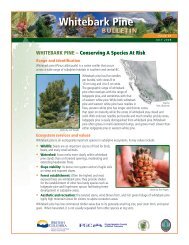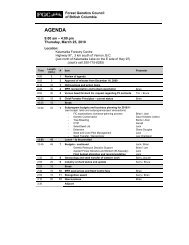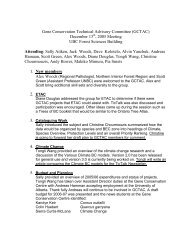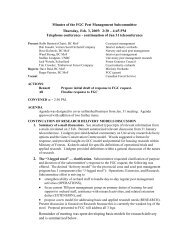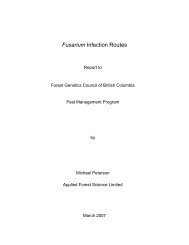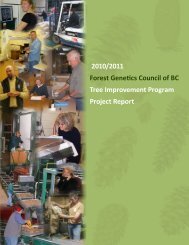Tree Improvement Program Project Report 2006 / 2007
Tree Improvement Program Project Report 2006 / 2007
Tree Improvement Program Project Report 2006 / 2007
You also want an ePaper? Increase the reach of your titles
YUMPU automatically turns print PDFs into web optimized ePapers that Google loves.
genotypes of interior lodgepole pine. Genotypes were<br />
selected on the basis of established seed cone production<br />
and pollination receptivity. Biweekly collections were made<br />
from genotypes located at Kalamalka Research Station from<br />
July to October, <strong>2006</strong>. Substantial inter-clone variation in<br />
the timing of female strobilus differentiation was found<br />
for the five clones analyzed. Female differentiation began<br />
in a period from late July to late August, depending on<br />
genotype. Lateral bud initiation and female bud initiation<br />
occur during the same period. In genotypes that showed<br />
male cone differentiation, sectioning revealed male cone<br />
buds had formed prior to our period of sample collection.<br />
These results suggest that cone induction may vary<br />
from two to three weeks between genotypes. Female<br />
differentiation in <strong>2006</strong> was earlier than previously reported<br />
in the literature.<br />
Introduct on<br />
Interior lodgepole pine, Pinus contorta Dougl. ex Loud. var.<br />
latifolia Englem, is an important timber-producing tree<br />
species of Canada (Rehfeldt 1999). Due to the defoliation<br />
of many lodgepole pine forests in British Columbia by<br />
the mountain pine beetle (Dendroctonus ponderosae), seeds<br />
are in great demand to mitigate the devastation of this<br />
pest (Anon. <strong>2006</strong>). Two options are possible to increase<br />
seed production: increase seed yield per cone or increase<br />
cone yield. Seed yield per cone is generally optimized<br />
by adequate pollination and reduction of seed losses. To<br />
increase cone yields, conifer seed orchards have historically<br />
utilized many different cone induction strategies such<br />
as root pruning, stem girdling, crown pruning, and<br />
application of fertilizers and plant growth regulators (PGRs)<br />
(Bonnet-Masimbert and Webber 1995). Although many of<br />
these practices have proven practical, interpretation of the<br />
responses can be unclear. In particular, questions about the<br />
timing of applications still abound. This is due to a specific<br />
lack of precise knowledge of phenological variability of<br />
individual genotypes. Without this knowledge, accuracy in<br />
method application could not be achieved.<br />
The legacy of a few generations of conifer morphologists<br />
has been a literature that describes various types of bud<br />
phenologies. Because the overall goal of such publications<br />
was to provide general outlines of bud formation, they were<br />
useful starting points for operational managers interested in<br />
studying bud development in their orchards. Operational<br />
improvements in induction treatments could be realized<br />
only if genotype-specific phenologies could be devised.<br />
These require close monitoring and an investment in<br />
6<br />
T R E E I M P R O V E M E N T P R O G R A M<br />
P R O J E C T R E P O R T 2 0 0 6 / 2 0 0 7<br />
studies of anatomy and morphology.<br />
Interior lodgepole pine has a reproductive cycle of<br />
three years. It has compound buds, in which both female<br />
and male strobili, short shoots, and lateral shoots are<br />
preformed and protected under sterile, lignified scales.<br />
In years of vigorous growth, interior lodgepole pine can<br />
display polycyclic growth (Greenwood 1980, O’Reilly<br />
1986). Buds that differentiate in the first year include male,<br />
female, short-shoot, and lateral-shoot buds. Each one is<br />
separately initiated in the axils of cataphylls along the axis<br />
of the long-shoot bud. Generally, males are located at the<br />
bottom or proximal portion of the axis and females and<br />
lateral-shoot buds are located at the top or distal portion of<br />
the axis. Development of these buds continues until winter<br />
dormancy. In the second year, development continues. Male<br />
buds mature and anthesis (pollen release) occurs. Female<br />
cones are receptive, but ovule development takes another<br />
year. Germinated pollen must wait in the nucellus until the<br />
female reproductive tissue matures. During the third year<br />
of development, fertilization finally takes place, followed by<br />
embryogenesis and seed maturation (Owens <strong>2006</strong>).<br />
Understanding the timing of female strobilus<br />
differentiation is an important factor in ensuring that the<br />
full potential of cone induction activities is realized. In this<br />
study, we performed histological analysis of long-shoot buds<br />
in the first year of development from five clones of interior<br />
lodgepole pine.<br />
Mater als and methods<br />
Plant material: Long-shoot buds of interior lodgepole<br />
pine (Pinus contorta var. latifolia) were collected from the<br />
Kalamalka Research Station near Vernon, BC. Ten buds<br />
were selected from a single ramet from each of five different<br />
clones: 1506, 1524, 1540, 1531, and 1539. <strong>Tree</strong>s were<br />
selected which were in from the periphery of the orchard<br />
by at least four trees; this was done to avoid edge effects.<br />
Collections were obtained from all areas of the crown of<br />
the tree. Serial collections were carried out at approximately<br />
two-week intervals from the beginning of July to the middle<br />
of October.<br />
Fixation: The long-shoot buds were cut transversely<br />
and radially using a scalpel to allow a rough separation of<br />
male and female axillary buds. This also allowed superior<br />
infiltration of fixative and subsequent solutions. The<br />
fixative was composed of 2.5% glutaraldehyde in 0.05 M<br />
Sorenson’s phosphate buffer (pH 7.2). Air bubbles were<br />
removed under vacuum at room temperature. Vials were<br />
stored in 4°C until further processing.



